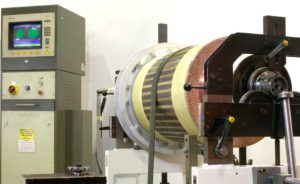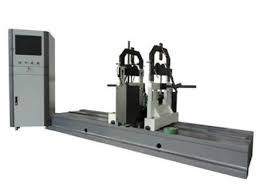Dynamic Balance
 A rotating system of mass is in dynamic balance when the rotation does not produce any resultant centrifugal force or couple. The system rotates without requiring the application of any external force or couple, other than that required to support its weight. If a system is initially unbalanced, to avoid the stress upon the bearings caused by the centrifugal couple, counterbalancing weights must be added. This is seen when a bicycle wheel gets buckled. The wheel will not rotate itself when stationary due to gravity as it is still statically balanced, but will not rotate smoothly as the centre of mass is to the side of the centre bearing. The spokes on a bike wheel need to be tuned in order to stop this and keep the wheel operating as efficiently as possible
A rotating system of mass is in dynamic balance when the rotation does not produce any resultant centrifugal force or couple. The system rotates without requiring the application of any external force or couple, other than that required to support its weight. If a system is initially unbalanced, to avoid the stress upon the bearings caused by the centrifugal couple, counterbalancing weights must be added. This is seen when a bicycle wheel gets buckled. The wheel will not rotate itself when stationary due to gravity as it is still statically balanced, but will not rotate smoothly as the centre of mass is to the side of the centre bearing. The spokes on a bike wheel need to be tuned in order to stop this and keep the wheel operating as efficiently as possible
Unbalanced systems
When an unbalanced system is rotating, periodic linear and/or torsional forces are generated which are perpendicular to the axis of rotation. The periodic nature of these forces is commonly experienced  as vibration. These off-axis vibration forces may exceed the design limits of individual machine elements, reducing the service life of these parts. For instance, a bearing may be subjected to perpendicular torsion forces that would not occur in a nominally balanced system, or the instantaneous linear forces may exceed the limits of the bearing. Such excessive forces will cause failure in bearings in short time periods. Shafts with unbalanced masses can be bent by the forces and experience fatigue failure.
as vibration. These off-axis vibration forces may exceed the design limits of individual machine elements, reducing the service life of these parts. For instance, a bearing may be subjected to perpendicular torsion forces that would not occur in a nominally balanced system, or the instantaneous linear forces may exceed the limits of the bearing. Such excessive forces will cause failure in bearings in short time periods. Shafts with unbalanced masses can be bent by the forces and experience fatigue failure.
Under conditions where rotating speed is very high even though the mass is low, as in gas turbines or jet engines, or under conditions where rotating speed is low but the mass is high, as in ship propellers, balance of the rotating system should be highly considered, because it may generate large vibrations and cause failure of the whole system.
